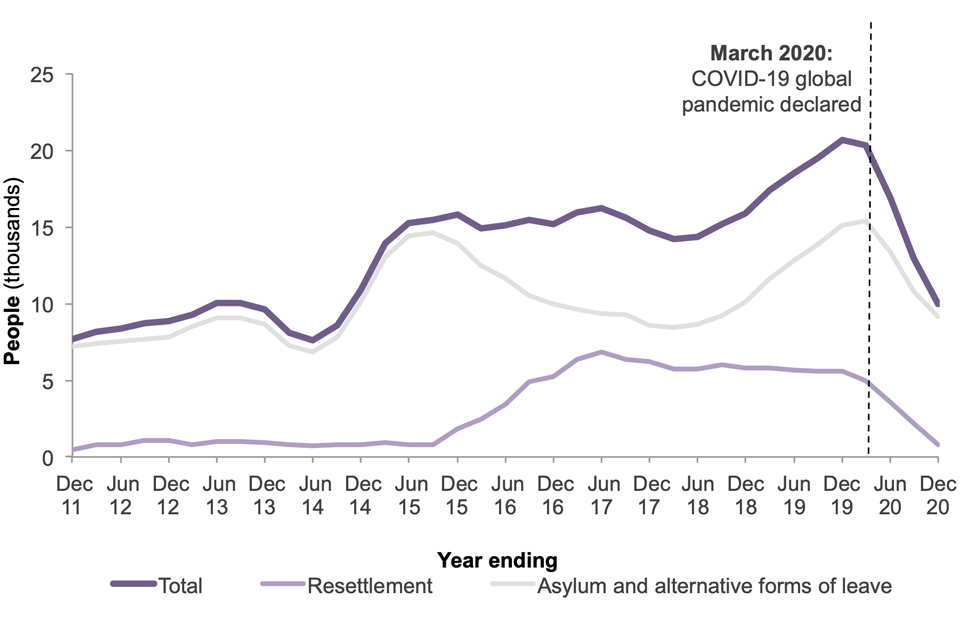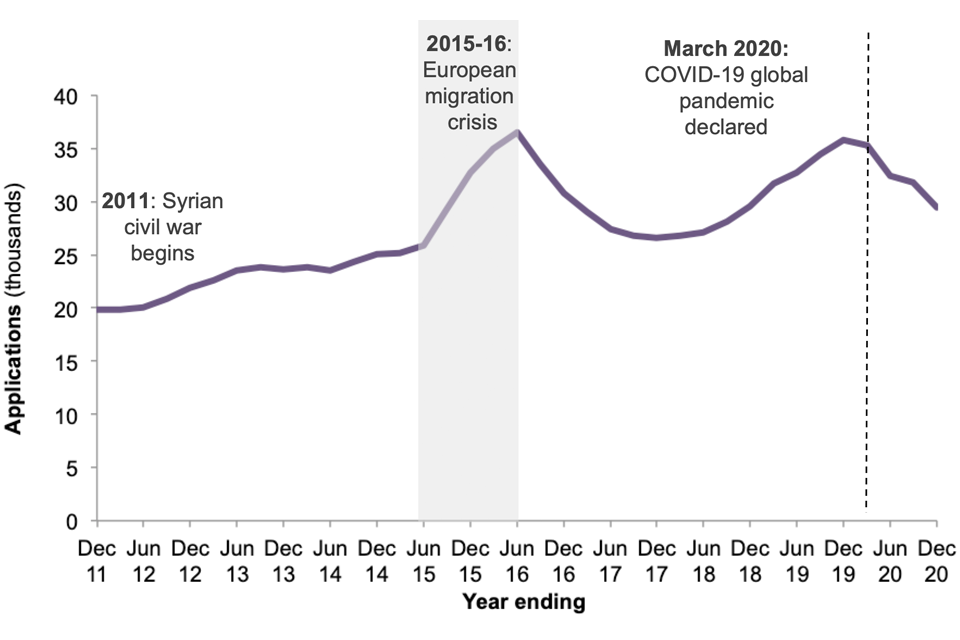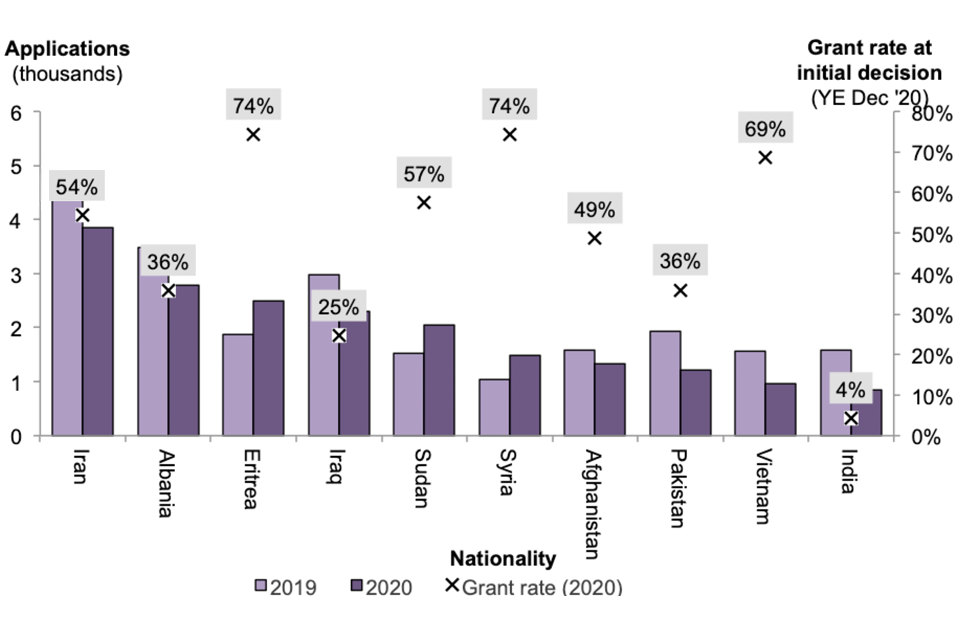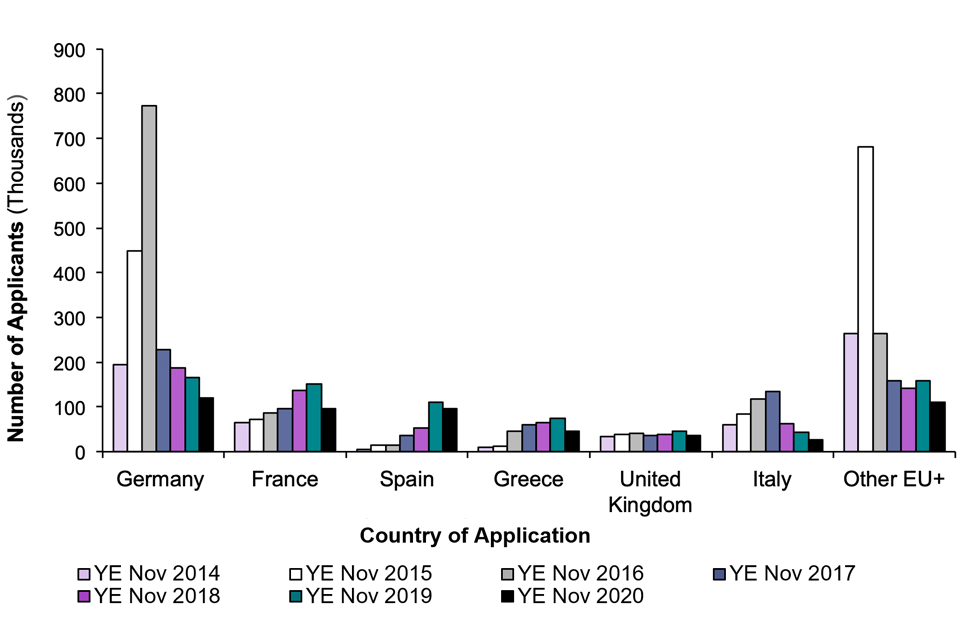How many people do we grant asylum or protection to?
Published 25 February 2021
Back to ‘Immigration statistics, year ending December 2020’ content page.
This is not the latest release. View latest release.
Data relate to 2020 and all comparisons are with 2019, unless indicated otherwise. An asylum application may relate to more than one person, if the applicant has family members (or ‘dependants’) which they request to be covered by the same application. This release features data on both the number of asylum applications or initial decisions (‘main applicants only’), and the number of people related to asylum applications and initial decisions (‘main applicants and dependants’).
On 11 March 2020, the World Health Organisation (WHO) declared the COVID-19 outbreak as a global pandemic. A range of restrictions relating to the outbreak began on 12 March 2020, the Foreign and Commonwealth Office (FCO) advised against all non-essential overseas travel on 17 March 2020, and advised all British travellers to return to the UK on 23 March 2020, the same day as the first UK lockdown measures were announced.
Restrictions were put in place across Europe and other parts of the world in the run up to the UK outbreak, which will also have impacted travel to the UK prior to these dates. The COVID-19 pandemic has had a significant impact on the UK immigration system, both in terms of restricting migrant movements to and from the UK and the impact on operational capacity.
Year ending comparisons that follow will include impacts resulting from the restrictions put in place during this period of the pandemic. Commentary specifically addressing changes over the course of the pandemic is also provided in section 5 ‘The impact of COVID-19’.
This section contains data on:
- Asylum applications and initial decisions, including unaccompanied asylum-seeking children (UASC)
- Resettlement
- Family reunion visas granted
- Asylum support
- Dublin regulation
1. People granted protection and other leave through asylum and resettlement routes
The UK offered protection, in the form of asylum, humanitarian protection, alternative forms of leave and resettlement, to 9,936 people (including dependants) in 2020. This figure is around half (48%) of the number in 2019, and the lowest level since 2014. The lower numbers of people given protection in the latest year is due to fewer initial decisions being made on asylum applications (14,365 decisions in 2020 compared with 20,766 in 2019), as well as the pause to resettlement activity after March 2020, both a result of the COVID-19 pandemic.
The number of grants of protection and alternative forms of leave in 2020 included:
- 7,546 people granted asylum, down 40% compared with the previous year, with the top nationalities receiving grants being Iranian (1,361), Eritrean (826), Sudanese (817), and Afghan (554) nationals
- 1,012 people granted humanitarian protection, down 18%; over half of these (54%) were granted to Libyan nationals; there was a notable increase in grants awarded to El Salvadorian nationals (168 up from 40), following an increase in applications since 2018
- 555 people granted alternative forms of leave following an application for asylum, down 57%
- 823 people granted protection through resettlement schemes, 85% fewer than in the previous year, due to the COVID-19 pandemic preventing resettlement activity between March-December 2020
In addition to those granted asylum, humanitarian protection and alternative forms of leave at initial decision following an asylum application, there will be additional people who receive a grant of protection following an appeal against an initial refusal (see section below on ‘Grant Rate’).
Additionally, 5,428 people were granted entry through Family reunion visas (issued to partners and children of those previously granted asylum or humanitarian protection in the UK), 27% fewer than the previous year.
Figure 1: People granted1 asylum, alternative forms of leave2, and resettlement3 in the UK, years ending December 2011 to December 20204,5

The number of people granted protection or other forms of leave has increased since year ending December 2011, from 7,645 to 9,936 in the year ending December 2020, which is down 52% from the previous year due to COVID-19.
Source: Asylum applications, initial decisions and resettlement – Asy_D02
Notes:
- Grants at initial decision. Actual number of grants at final decision (following appeal) will be higher.
- ‘Alternative forms of leave’ include grants of humanitarian protection, discretionary leave, grants under family and private life rules, leave outside the rules and UASC leave, that resulted from an asylum application.
- Resettlement data prior to 2013 are only available annually. Data for individual quarters in this period have been estimated by taking 25% of the annual total.
- Includes main applicants and dependants.
1.1 Resettlement
There were 823 people granted protection through resettlement schemes in 2020, 85% fewer than in the previous year. The vast majority were resettled in the first quarter of the year before resettlement activity was paused due to the impact of the coronavirus pandemic. There was no resettlement during the second and third quarters of 2020. Resettlement activity recommenced in December 2020, although only eight refugees were resettled that month.
The Vulnerable Person Resettlement Scheme (VPRS) accounted for 80% (662) of those resettled in the UK (823) in 2020. Since the government announced the expansion of the scheme on 7th September 2015, including the target of resettling an additional 20,000 refugees under the scheme by 2020, 19,776 refugees have been resettled in the UK (99% of the 20,000 target) and there are plans to bring the final arrivals under the Vulnerable Person Resettlement Scheme in early 2021.
A further 79 people were resettled under the Vulnerable Children Resettlement Scheme (VCRS) in 2020, bringing the total to 1,826 since this scheme began in 2016.
Of those resettled under the VPRS and VCRS in 2020, 25 refugees were resettled in the UK through the Community Sponsorship scheme. Since these schemes began in July 2016, 449 refugees have been resettled by community sponsor groups.
More information about the various schemes can be found in the ‘About the statistics’ section.
Once 20,000 VPRS refugees have been resettled, the UK has announced plans for a new resettlement scheme, which will consolidate the Vulnerable Persons Resettlement Scheme, the Vulnerable Children’s Resettlement Scheme and the Gateway Protection Programme into one global scheme.
2. Asylum applications
There were 29,456 asylum applications (relating to 36,041 people) in the UK in 2020, an 18% decrease from the previous year but similar to levels in 2018. The latest figure will have been impacted by the measures taken in response to COVID-19 which have impacted migrants’ movements globally.
Figure 2: Asylum applications lodged in the UK, years ending December 2011 to December 20201

Applications rose slowly from 2011 to 2015, and more rapidly in the European Migration crisis (2015-16). Applications fell after the crisis but by the end of 2019 had returned to similar levels. Levels have fallen since March due to COVID-19.
Source: Asylum applications, initial decisions and resettlement – Asy_D01
Notes:
- Includes main applicants only.
Despite falls in the latest year, Iran was the top nationality claiming asylum in the UK in 2020, as it has been in every year since 2016 (3,847 applications, down 21% compared with the previous year), followed by Albania (2,784, down 20%).
Over half (54%) of applications from Iranian nationals were granted at initial decision, compared to around a third (36%) of those from Albanians, although additional numbers may be granted following appeal.
The majority of nationalities experienced a decrease in the number of applications. Of the top 10 nationalities applying to the UK only three experienced an increase (Eritrea (up 33%), Sudan (up 34%) and Syria (up 43%)).
Figure 3: Top 10 nationalities1 claiming asylum2 in the UK and grant rate3,4 at initial decision (%), 2019 and 2020

Of the top ten applying nationalities, Eritrea and Syria have the highest grant rates (both at 74%), and India has the lowest grant rate, at 4%.
Source: Asylum applications, initial decisions and resettlement – Asy_D01 and Asy_D02
Notes:
- Top 10 nationalities in the most recent year.
- Includes main applicants only.
- The percentages in the chart are the grant rate at initial decision for each nationality in the most recent year.
- Grant rate is the proportion of initial decisions which resulted in a grant of protection or other leave. Grant rate is based on year of initial decision and is not directly comparable to applications, which are based on the date the asylum application was made.
Eurostat Asylum statistics report the total number of asylum seekers including both main applicants and other family members (dependants). These show the fall in UK asylum applications was similar to the trends seen more widely across Europe. Comparing to the previous year, the total number of asylum applications across the EU+ (countries in the EU, EEA and Switzerland) decreased by 30% and the UK decreased by 23% in year ending November 2020 (the latest period available for comparable statistics). Falls in applications were seen across most of the EU+ countries, including Italy (down 39%), France (down 36%) and Germany (down 28%); exceptions to this include Romania, Bulgaria, Croatia and Slovakia.
In the year ending November 2020, the highest number of applications received in the EU+ were received by Germany (120,320 applications) and France (96,030 applications). In the same period, the UK received the 5th largest number of applications (35,355 applications) when compared with the EU+ member states, around 7% of the total asylum application in the EU+ and UK. This would represent only the 17th largest intake when measured per head of population.
Figure 4: The number of asylum applicants to the top five countries1 in the EU+ and the UK for the years ending November 2014 to November 20202,3

While many countries had a substantial increase in 2015 and 2016 due to the European migration crisis, the UK experienced a smaller increase compared to other European countries.
Source: Eurostat Asylum statistics
Notes:
- Top 5 countries receiving asylum applications in the most recent year.
- Includes main applicants and dependants.
- The ‘Other EU+’ category includes all other countries that are European Union member states, part of the European Economic Area, and Switzerland.
2.1 Grant rate
In 2020, there were 14,365 initial decisions made on asylum applications, and just under half (46%) of these were grants of asylum, humanitarian protection or alternative forms of leave (such as discretionary leave or UASC leave), down from the previous year (52%). Many of those refused asylum at initial decision go on to appeal. Data from the Home Office ‘cohort’ analysis, published annually in Asy_D04, show that the final grant rate typically increases by 10 to 20 percentage points following appeal. More detailed analysis of the final outcome of asylum applications can be found in the year ending June 2020 edition of Immigration Statistics.
Grant rates vary considerably by nationality as the protection requirements of specific groups or individuals vary, usually depending on the situation in their home country. Of those nationalities that commonly claim asylum in the UK, Libyans (93%) and Eritreans (74%) typically have high grant rates at initial decision, while nationals of India (4%) and Bangladesh (17%) have low grant rates.
Although over the last year the grant rate at initial decision has decreased from 52% in 2019 to 46% in 2020, the grant rate is higher than the levels prior to 2019, when around a third of initial decisions were grants. The overall grant rate can vary for a number of reasons, including the protection needs of those who claim asylum in the UK, along with operational or policy decisions.
3. Support provided to asylum seekers
At the end of 2020, 45,626 asylum seekers in the UK were in receipt of support under Section 95 of the Immigration and Asylum Act 1999, a 5% increase on the previous year (43,549). Of these, 41,302 (91%) were in receipt of both accommodation and subsistence, and 4,324 (9%) in receipt of subsistence only.
More than four fifths (83%) were located in England, with smaller supported populations in Scotland (9%), Wales (6%) and Northern Ireland (2%).
The top 5 nationalities in receipt of Section 95 support at the end of December 2020 were from Iraq (6,443 people), Iran (4,630), Albania (4,537), Pakistan (3,108), and China (2,690). These 5 nationalities together represent almost half (47%) of the total people receiving Section 95 support, but account for 36% of the total number of people applying for asylum (including dependants) in 2020.
An additional 6,180 individuals were in receipt of support under Section 4 of the Immigration and Asylum Act 1999, providing support where a claim has been rejected but the individual is temporarily unable to leave the UK, up 62% from the previous year (3,804).
There were 12,235 individuals in receipt of support under Section 98, nearly 3.5 times higher than the same time in the previous year (2,738). The sharp increase is likely related to COVID-19. For further information follow the link detailing the use of temporary hotels to house asylum seekers during COVID-19. Section 98 support is provided to asylum seekers on a short-term basis while their application for Section 95 support is considered.
In 2020, there were 20,994 applications for Section 95 support, up 5% from the applications received in 2019 (20,009).
4. Dublin Regulation
In 2020, there were 2,331 requests from EU member states to transfer individuals into the UK. There were 882 transfers into the UK. The majority (551) of these transfers came from Greece. The number of requests from EU states into the UK in 2020 are similar to levels seen in 2019 and the number of transfers from EU increased by 24%.
In 2020, there were 8,502 requests from the UK to transfer individuals out of the UK to EU member states, which is over 2.5 times higher than the number of requests for transfers out made in 2019. This increase is due to a rise in the number of arrivals via small boats across the English Channel in 2020. Many of these arrivals were found to have previously applied for asylum in an EU member state and therefore requests were made to transfer these individuals back to those states. There were 105 transfers out of the UK, a decrease of 60% compared to the number of transfers out in 2019. This decrease in transfers out is due to the international travel restrictions put in place in response to COVID-19 and the suspension of all Dublin transfers by EU member states between late February and July 2020. Of the transfers that took place in 2020, 43 (41%) were transfers to Germany and 25 (24%) were transfers to France.
5. The impact of COVID-19
The number of asylum applications had been increasing in 2018 and 2019. However, applications fell sharply in April 2020 following the onset of the global pandemic, and although they increased somewhat over subsequent months, they have not returned to the levels seen prior to the coronavirus pandemic. Asylum applications in the fourth quarter of 2020 were 23% lower than the same quarter in the previous year.
The number of initial decisions on applications also decreased in 2020, by 31%. Following falls in March and April 2020, there was a sharp increase in decisions being made between May and July 2020, numbers dropped again between August and September but have subsequently increased in the last three months of the year.
The reduced number of decisions means the number of people granted protection has fallen. In the fourth quarter of 2020 (October to December 2020), the number of people granted protection or other forms of leave was 43% lower than in the same period in 2019.
There was also a substantial decrease in the number of people granted protection through resettlement schemes, 85% fewer than in the previous year, due to the COVID-19 pandemic preventing resettlement activity between March-December 2020.
Over the past year, there were increases in the number of individuals supported across all support types. Section 98 saw the largest increases (from 2,738 to 12,235) but Section 4 and Section 95 also saw increases (from 3,804 to 6,180 and from 43,549 to 45,626 respectively). These increases are also likely due to the impact of the pandemic.
6. About the statistics
This section provides information on those applying for and granted protection in the UK through both asylum and resettlement routes, as well as information on the numbers in receipt of asylum support.
The data are used to assess the trends in numbers of people seeking and being granted protection, the impact of policy changes, and to understand the demographics of those coming to the UK to claim protection. Data on resettlement and support, broken down by local authority, can help local authorities understand the demands on their services and resources to aid with planning.
The Home Office published an ‘Indicators of Integration framework’ in 2019, which provides a framework to support local and national practitioners in developing strategies and in measuring progress in the integration of refugees and other groups.
6.1 Asylum, resettlement and protection
The total number of individuals granted protection includes grants related to an asylum application (grants of asylum or alternative forms of leave) and resettlement. Alternative forms of leave include humanitarian protection, discretionary leave, UASC leave, leave outside the rules, and grants under family and private life rules. Further details can be found in the user guide.
Data on asylum applications relate to the period in which the application was lodged, and initial decisions relate to the period in which the decision was made. Initial decisions may, therefore, relate to an application made in an earlier period, and thus the two are not directly comparable.
Data on initial decisions will not reflect the total number of people granted protection through asylum routes as some initial decisions may be overturned following appeal. Data on the number of appeals lodged, and their outcomes, are published in Asylum appeals lodged and determined – Asy_D06 and Asy_D07.
UASC data includes those treated as an unaccompanied minor for at least one day between the date of application and the date of initial decision. Some UASC applicants may subsequently be found to be an adult following conclusion of an age dispute. Data on age disputes are published in Age Disputes – Asy_D05.
Eurostat asylum statistics can be used to compare asylum statistics with EU member states. The methodology used to compile Eurostat data differs from that used in this release. Further details can be found in the user guide.
The UK Community Sponsorship scheme was launched on 19 July 2016. The scheme allows community groups to support refugee families directly and aims to help them become self-sufficient and integrated members of the community. These figures are a subset of those published under the VPRS and VCRS and are not in addition to those resettled under these schemes. Further details can be found on the Community sponsorship scheme launched for refugees in the UK page.
Family reunion visas are a subset of the ‘Family – other’ visa category, published in the visa tables. The vast majority of ‘Family – other’ visas related to family reunion visas. Data on Family reunion visas come from a different administrative system to other visa data so are not directly comparable. Further details can be found in the user guide.
6.2 Support provided to asylum seekers
Due to technical data extraction issues, assured figures for the Section 95 and Section 4 supported populations for the fourth quarter of 2020 have been taken from beginning of December (04/12/2020) rather than normal end of month.
Section 95 support is provided to destitute asylum seekers until their claim is finally determined, which may encompass either accommodation or subsistence, or both.
Section 4 provides support for individuals whose claim has been refused and who have exhausted their appeal rights, but who are destitute and are temporarily unable to leave the UK.
Section 98 support provides accommodation for asylum seekers who would otherwise be destitute and who are either awaiting a decision on an application for Section 95 support or are supported under Section 95 and are awaiting transfer to their accommodation.
The data show the number of people in receipt of support on a given day, but do not show the length of time for which someone receives support or the amount of support they receive.
6.3 Dublin
The Dublin Regulation is EU legislation that establishes the criteria and mechanisms for determining which single state is responsible for examining an application for international protection. Further details on the Dublin Regulation are set out in the user guide.
As of 31st December 2020, the UK’s transition period for exiting the EU came to an end. As a result, the UK is no longer subject to the Dublin regulation. Although no new requests are permitted from 01 January 2021 onwards, there may be requests made to the UK under the Dublin regulation prior to the end of the transition period that will result in transfers in 2021, where the requests have been sent to the UK prior to the end of the transition period. We continue to return migrants to safe countries on a case-by-case basis.
The data published in this space will be kept under review in line with future policy developments.
Data on transfers out of the UK under the Dublin Regulation are a subset of the published returns data found in ‘How many people are detained or returned?’.
6.4 Section 67 of the Immigration Act 2016
Section 67 of the Immigration Act 2016, also known as the ‘Dubs’ amendment, committed the UK to bring 480 unaccompanied asylum seeking children (UASC) to the UK from Europe.
Data on those who have transferred to the UK under the ‘Dubs’ scheme was published in Immigration Statistics, year ending June 2020.
Further details about the scheme can be found in the ‘Dubs Factsheet’ on GOV.UK.
7. Data tables
Data referred to here can be found in the following tables:
Additional data relating to asylum, protection and resettlement published in earlier Immigration Statistics releases include:
- Transfers to the UK under Section 67 of the Immigration Act 2016
- Asylum claims on the basis of sexual orientation
We welcome your feedback
If you have any comments or suggestions for the development of this report, please provide feedback by emailing MigrationStatsEnquiries@homeoffice.gov.uk. Please include the words ‘PUBLICATION FEEDBACK’ in the subject of your email.
We’re always looking to improve the accessibility of our documents. If you find any problems or have any feedback relating to accessibility, please email us.
See section 7 of the ‘About this release’ section for more details.
